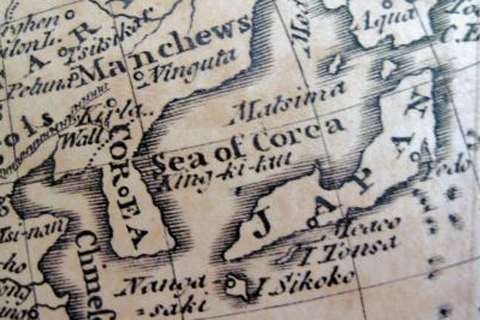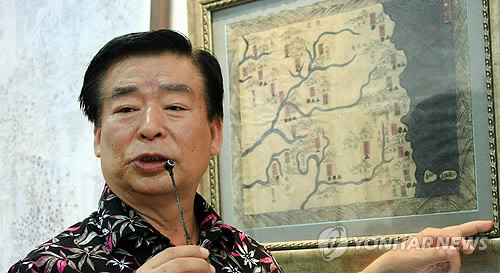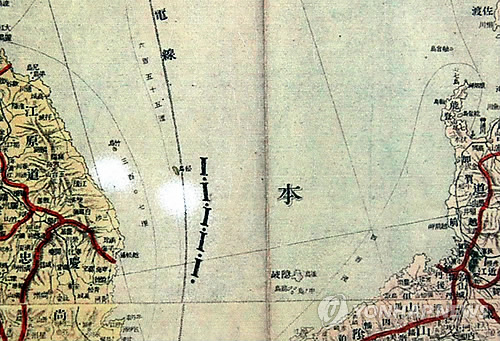日本海に浮かぶ欝陵島Dageletの話をたまに書いているわけですが、それはもともと、欧米の水路誌や地図でTakeshima Argonaut, matsusima Dagelet とLiancourt Rocksの記述を探しているついでに日本海呼称問題とかぶる部分があったためこのブログをはじめたわけですが、まあ、私もこの島に渡航したことがあるのでたまにDagalet欝陵島の事について書いているわけです。
半月城という朝鮮のネットウヨクは1990年代から主にインターネット上でエスのセントリズム的な主張を行っては、Torazo氏やYabutarou氏、Oppekepe氏などにその嘘を指摘され論破されてはまた別の歪曲論拠を用いたり、証明ロンダリングをおこなって印象操作をしているネトウヨですが、最近は啓明大学で”論文”なるものを書いているようだが、またこの内容が酷い。
---以下、引用---
欝陵島に住む韓国人と日本人は共同で十数年前に于山島を探索したが失敗して于山島を見失っていた。上の記事が書かれたのは1913年なので、それから十数年前というと1900年前後になる。すなわち禹用鼎が釜山領事官補 赤塚正助と欝陵島の合同調査をおこなった年の前後に于山島の探索がおこなわれたことになる。 ちなみに合同調査後に赤塚が外務省宛の報告書「欝陵島調査概況」(1900)に添付した欝陵島地図は図2のとおりである。図2にて欝陵島の東北に「空島」が、島牧(観音島)や竹島(竹嶼)よりも大きく描かれた。おそらく、付属地図は「空島」を伝説の于山島に想定したものの、于山島の存在が確実でないので、于山島の名を避けて無人島の意味で「空島」と名付けたと思われる。もし、この「空島」が于山島であると判明したなら、「空島」はもちろん勅令41号に于山島の名で記述されたであろう。于山島は官撰書に記載された歴史的な名称なので、当然于山島を勅令に記載したはずである。しかし、住民は伝説の「東北」方向に于山島を探し出せず、探索は失敗に終わった。そのため、存在が曖昧な于山島を勅令に掲載するのを見送ったものと思われる。この人は、地図すらろくに読めないのか、それとも意図的に歪曲をこじつけようとしているのかわからないが、この地図に書かれた
空島(Gong-do)をみると、それは「
図2にて欝陵島の東北に「空島」」 ではなく、『北』に書かれていることがわかる。 『北東』ではない。 そして、半月城氏は、「「
付属地図は「空島」を伝説の于山島に想定」」と述べているが、とんでもない歪曲です。この空島(Gond-do)は、今日の孔岩(Gong-am:一名象岩)です。
ここに書かれている空島(Gong-do)は、光岩や錐山の北、天府洞の北西に書かれているわけですこの1900年の赤塚報告の欝陵島添付図と、1918年の総督府作成の欝陵島図を比べてみてもその相対的な位置関係を比較すれば一目瞭然です。

まあ、百歩譲って欝陵島の地図の中心地点を西寄りに設定した場合、北北東にあると主張することはできるかもしれませんが、これ地図単純に見て、「北」に書かれている、とみなすのが妥当です。 この空島、大きさは実際より大きく書かれているわけですが、
それは該当の岩が非常に目立ち、目印となるためでしょう。とにかくこの孔岩は目立つのです。この空島は欝陵島北部に書かれた地区名、
光岩、錘山の北側の海中にあり、また天府堂の北西に書かれていることから、との相対関係から孔岩(Gong-am)
つまり今日の象岩と判断できます。 決して、「
付属地図は「空島」を伝説の于山島に想定」して書いたような妄想ではありません。

赤塚の欝陵島地図

欝陵島地図

この地図の、1番がずばりその孔岩(象岩)です。玄圃や天府の北の沖合いにある、非常に目立つ欝陵島の観光スポットです。 (ちなみに、4が島項観音島で、5が竹嶼Boussoule Rockです。)
この孔岩は、
・1694年以降の朝鮮王朝の鬱陵島捜討官の製作した鬱陵島詳細図にも記載されています。
おそらく、この半月城という人物は、1900年の赤塚の調査と、1913年の新聞記事、「于山島探検中止 」の件を無理やり結びつけるために「空島」の位置の説明を歪曲したと考えられます。
こういう、馬鹿な話は、実際に欝陵島に行って現地を見てきた人間には通用しないです。
当初、『
住民は伝説の「東北」方向に于山島を探し出せず、探索は失敗に終わった』事は、以下の文献で、Gerrybeversがそもそも紹介しているものなのですが、
于山島探検中止 (Gerrybevers)
http://dokdo-or-takeshima.blogspot.com/2008/04/location-of-usando-unknown-in-early.htmlこれによると、
『
慶南鬱島郡 西面 金元俊은 鬱島로부터 東北方 約四、五十里를 』
のわけです。つまり、欝陵島北東部400-2.2km先にある竹嶼や観音島よりもさらに遠方の北東にあると彼らは推測していたわけで、決して、欝陵島のほぼ真北の近場にか書かれた島を探そうと思ったわけではないのです。
、赤塚が「
付属地図は「空島」を伝説の于山島に想定」したのであるならば、島項(石圃の対岸:観音島)や竹島(竹嶼)のさらに北東の海上に「空島」を書くでしょうに(笑) でないと、「地図」としての意味がないですよ(笑)
。この孔岩は、名称の誤差はあれども、1880年、つまり欝陵島再開拓が始まった後の調査地図にはおおよそ掲載があります。。つまり、欝陵島の地理上、孔岩は「顕著」なものなのです。
http://seaofjapan-noeastsea.blogspot.com/2010/11/1900-1905.html



該当の論文?PDF P2とやらにも、
「
石島が観音島でないとすれば、欝陵島付近には他に石島の候補になりうる島はないので石島は竹島=独島しかあり得ない」
って書いてるようですが、このように、空島(孔岩)も候補に挙がるわけですし、また、発音を根拠に「観音島が石島である」という根拠が薄れただけで、まだ、観音島が石島であると推測する材料は残っているわけです。 ”獨島が石島”であることを
推測し始めた最初の頃も崔南善は「
鬱陵本島のごく近くにも別のドクソムがある」と述べているとおり、別の「ドクソム」なるものが欝陵島の近くにあることを示唆しています。
参照:藪太郎の研究室 http://outdoor.geocities.jp/yabutarou01/a.html?sid=98989d8ec8111d9ae5b99f846fc98241実は、この欝陵島調査員赤坂の地図は、結構前に皆で吟味したわけですが、
http://dokdo-or-takeshima.blogspot.com/2008/04/1900-japanese-map-of-ulleungdo.htmlhttp://seaofjapan-noeastsea.blogspot.com/2010/11/1900-1905.html赤坂は、現地に行っていること、そして報告書を書いていることを考えると、この地図は実際に現地を調査して地名などを聞き取り調査して作成したと考えられるのが妥当で、
赤塚が決して妄想で、『
付属地図は「空島」を伝説の于山島に想定した』 のではなく、ただ単に、目印としては非常にわかりやすい今日の象岩である孔岩Gong-amを島として書いた程度だと考えられます。この孔岩、確かに小さな岩なのですが、かなり目立つ岩で欝陵島の観光スポットの中でも有名なうちのひとつですし、その存在は大きいんです。

今は削除されていますが、過去に独島学会は、1881年の
李奎遠の欝陵島外図に描かれた虹●岩、つまり今日の孔岩/象岩を、「
独島」であると、とんでもない歪曲を主張していたんですね。

(地図に関しては、下記の4・ソウル大学 鬱陵島外図を参照のこと
http://outdoor.geocities.jp/yabutarou01/1.html実際、この地図の形を見ればそれはやはり「孔岩」つまり象岩以外の何者でもないのです。しかし、当時韓国側はHPでこれを「独島」であると主張しいました。 日本の一般人が欝量島の詳細など知らんと高をくくっているのでしょうね? 今回の赤塚の地図に書かれた空島をウサン島にあてがおうとする魂胆とすごくそのときの状況に似ているわけです。手法が。
現地の地理を知らない人間は簡単に信じるのかもしれませんが。
まず、赤塚の地図と、このウサン島移住調査が関連していることを示す形跡は史料上見られない。
1899-1900年のフランス人のLa Porte、日本人の赤塚、そして大韓帝国の役人、禹用鼎の合同調査ですが、「ウサン島への移住のための民間の調査」と関連している様子は史料からはみられません。
La Porteの報告ー皇城新聞 1899.09.23の記事
http://dokdo-or-takeshima.blogspot.com/2008/05/1899923.html赤塚の報告-(+渡邊鷹治郞)
http://dokdo-or-takeshima.blogspot.com/2008/04/1900-japanese-map-of-ulleungdo.html禹用鼎の調査記録ー「欝島記」
http://dokdo-or-takeshima.blogspot.com/2007/12/1900-uldo-gi.html日本人と韓国人が移住のために調査を行ったのかもしれませんが、それが上記三方による合同調査と関連がある節は見られませんし、また、赤塚の地図に記載された空島が「ウサン島」として記載したという根拠はないわけです。
そもそも、日本人も、韓人も、もともとは
皆、りゃんこ島と呼んでいたわけです。 日本人は1880年頃から、すでに日本人は欝陵島の南東50日本里に、「りゃんこ島」があることは知っておりますし、朝鮮人は1903年頃から日本人に 雇われて「りゃんこ島」に渡航しているわけですから、仮に現地人や日本人がりゃんこ島を「ウサン島」とみなしていた場合、移住のための捜索をするはずがあ りません(笑) 1902年の欝陵島の報告書にも、「「りゃんこ島」は南東25海里にあると記載があります。
皆、りゃんこ島と呼んでいたわけです。その、欝陵島の南東はるか90KM先にあるりゃんこ島を現地人なり日本人なりが「于山島」と認識していたとすればそれをそう記載していたわけですし、 1900年の赤塚の地図には「
北東部」、 「北部」ではなくて、「南東部」に「りゃんこ島」と書いたでしょう。(笑)そして、なにも日本と朝鮮人との「合同ウサン島調査」は北東50里に調査に行く はずがないんです(笑)。 半月の仮説を元にすると、以下のような地図を書いていたのではないか、と思いますが、もちろん実際は前述のとおり、 空島は孔岩を書いたわけです。

つまり、この1913年の「于山島探検中止」の新聞記事は、于山島は島根の竹島「独島」ではない、といっているようなものなの です。
そこで、韓国側は、おそらくは、「赤塚の地図を根拠にすると、竹嶼が于山島でない」と反論があるかもしれません。
赤塚の地図に于山島が記載されない理由は、この時代はすでに、
「于山」は再び鬱陵島の古い旧名に戻っていたからです。 欝陵島詳細古地図に記載された于山島は「竹島(嶼)」とかかれるようになったのです。































